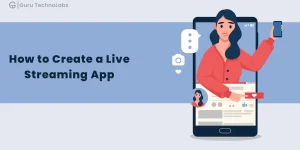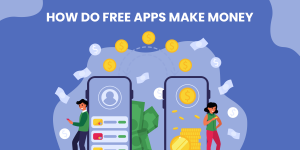OTT App Development Cost in 2025: Breakdown, Monetization & Cost-Saving Tips
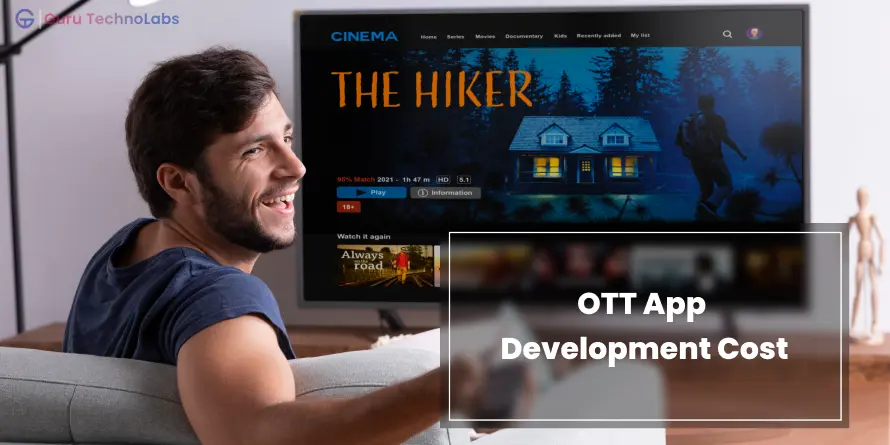
Nowadays, the way we consume media has undergone a significant transformation. Over-the-top (OTT) platforms have become the go-to choice for people worldwide to stream movies, binge-watch series, and enjoy on-demand content at their convenience.
So, in this competitive market, creating your OTT app is a great way to grow your business and increase revenue. But when you are thinking of development, one of the most important questions arises: “What will the OTT app development cost be?”
In this blog, we will discuss the key factors influencing OTT platform development costs. Along with that, we will explore different development approaches and provide insights into how businesses can plan their budgets effectively.
So, let’s get started with key insights and statistics on the OTT market.
Why Should You Invest In OTT App Development?
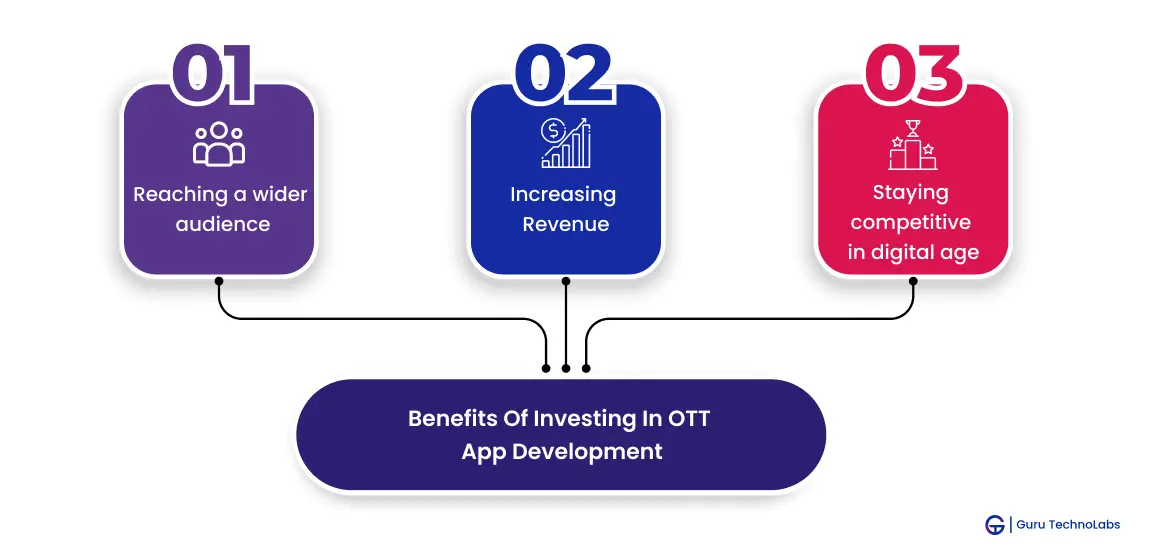
Investing in OTT app development can be a smart move for your business, considering the current trends in media consumption. With the rise of over-the-top (OTT) platforms like Netflix, Hulu, and Disney+, people spend more time streaming movies, TV shows, and on-demand content online. This shift in consumer behavior presents a lucrative opportunity for businesses to tap into a growing market and increase their revenue.
OTT platforms offer convenience and flexibility to users, allowing them to watch their favorite content anytime, anywhere, on any device with an internet connection. This accessibility has led to a significant increase in users and the time spent streaming content online.
By investing in OTT app development, businesses can reach a wider audience and engage with their customers in a more meaningful way. With features like personalized recommendations, social sharing, and offline downloads, OTT apps can enhance the user experience and keep viewers coming back for more.
Additionally, OTT platforms offer monetization opportunities, such as subscription-based models, pay-per-view rentals, and advertising revenue. This diversity in revenue streams can help businesses generate consistent income and maximize their return on investment. Furthermore, developing an OTT app allows businesses to stay competitive in an ever-evolving media landscape. With traditional TV viewership declining, OTT platforms offer a modern and innovative way to distribute content and connect with audiences.
In short, investing in OTT app development can provide businesses with numerous benefits, including reaching a wider audience, increasing revenue, and staying competitive in the digital age. With the right strategy and execution, an OTT app can be a valuable asset for any business looking to capitalize on the growing demand for online streaming content.
Now let’s see the current statistics of the OTT market.
Current Market Status of OTT Platforms
Here, you will get to know about the latest statistics and market trends shaping the dynamic landscape of OTT platforms.
- Users spend 17 hours streaming online video content weekly on OTT platforms.
- The projected revenue in the OTT Video market worldwide is estimated to reachUS$316.40 billion by 2024..
- The average viewer spends$50 monthly on streaming servicesacross four different platforms, with Netflix being the most popular.
- Over 70% of OTT users binge-watch content.
- The global number of users in the ‘OTT Video’ segment of the media market was forecast to continuously increase between 2023 and 2028 by 862.8 million users.
- The largest market segment within the OTT Video market is OTT Video Advertising, which is expected to have a market volume of US$191.30 billion in 2024.
So, the above statistics clearly say that the idea of developing an OTT platform is worth it.
How Much Does OTT Platform Development Cost?
The cost of developing an OTT platform can vary widely based on specific project requirements and goals. Here are some estimated costs:
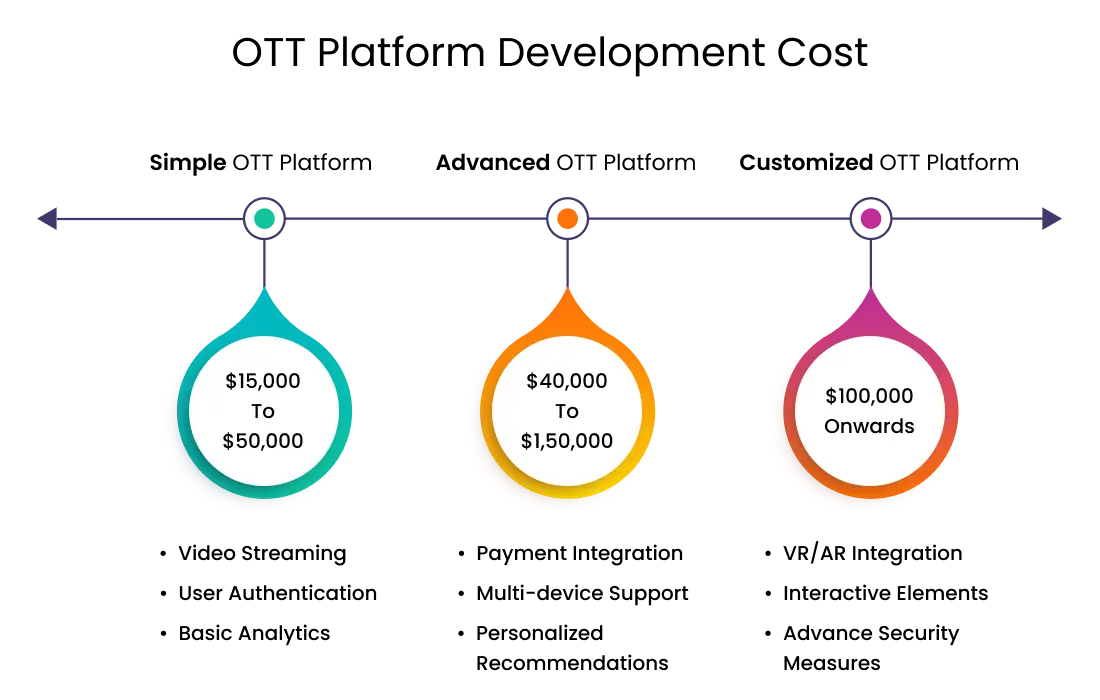
If you want to develop a simple OTT platform, the cost can range from $15,000 to $50,000. It includes standard features like video streaming, user authentication, basic analytics, and content management.
For a more advanced OTT platform, the cost could range from $40,000 to $150,000. It includes additional features such as personalized recommendations, payment integration, social sharing, multiple device support (web, mobile, smart TVs), and advanced analytics.
Moreover, depending on complexity, if you want a highly customized OTT platform with unique features, the cost could range from $100,000 to several million dollars. It includes unique features, extensive content libraries, advanced security measures, interactive elements (e.g., live chat, polls), VR/AR integration, and scalable infrastructure.
Also, note that the cost is estimated and varies based on factors such as development team rates, project timeline, third-party integrations, scalability requirements, and ongoing maintenance expenses.
To get a more accurate cost estimate for your specific OTT platform, it’s recommended that you consult an experienced OTT platform development company. The team of experts help you assess your requirements and provide detailed pricing based on your unique needs.
Factors Influencing OTT Platform Development Costs
Let’s have a look at the key factors that play a crucial role in determining the overall cost of developing an OTT app or platform.
1. App Functionality
One of the significant factors that impact OTT development cost is the complexity and range of features included in your app. Each feature adds complexity to the development process, which requires more time and resources to implement OTT solutions.
The best way is to develop an MVP app with the required basic features.
A few of the essential features are:
- Watchlist
- Search and recommendations
- User profile
- Social features
- Screen mirroring
- In-app purchases
- Offline downloads
- Push notifications
It also allows for iterative development, enabling you to add more advanced features based on user feedback and market demand while managing development costs effectively.
2. Type of OTT Platform
The type of OTT platform you choose to develop significantly influences development costs. Let’s look at the cost of different types of platforms:
- Developing a VOD platform will cost you between $20,000 to $150,000 for basic features, while more advanced VOD platforms with personalized recommendations and extensive content libraries can range from $100,000 to $500,000 or more.
- If you are building a live streaming platform, the cost starts from $50,000 and can go up to $1 million or more for high-end solutions. It involves additional complexities such as real-time content delivery, interactive features, and scalability requirements.
- For a subscription-based OTT platform, the development cost increases by 20% to 50% compared to ad-based models. It includes payment integration, user authentication, and other additional features.
- Advertising-based OTT platforms’ costs will begin at $20,000, and it includes integrating advertising capabilities into your OTT platform for ad serving, targeting, and analytics.
So, choose the right type of OTT platform that aligns with your business goals and target audience. It is crucial to manage development costs effectively while maximizing revenue potential.
3. Choice of Platform
The platform you choose significantly impacts development costs. Whether it’s web-based, mobile app (iOS/Android), or a combination of these, each platform has its unique development requirements, user interface considerations, and compatibility challenges that influence the overall cost of the project.
- Web-Based Platform: Developing an OTT platform for web browsers can cost you around $10,000 to $100,000. The cost varies as it depends on the complexity and features required. However, the approach is more cost-effective compared to mobile platforms.
- Mobile (iOS/Android) Platform: Creating native mobile apps for iOS and Android devices starts from $20,000 and can exceed $500,000 for complex apps with advanced features. It involves additional development efforts, as each platform requires separate coding and optimization. For businesses looking to streamline the process, partnering with a reputable mobile app development company in USA can ensure high-quality results while managing costs effectively.
- Cross-Platform Development: If you want to opt for cross-platform development frameworks like React Native or Flutter, it can reduce development costs. It allows code sharing across multiple platforms, which reduces half of the time of development and the overall OTT cost.
Also, keep in mind to carefully evaluate the target audience and platform preferences. It helps you determine the most cost-effective approach for developing OTT platforms which ensure compatibility and user experience across different devices.
4. Content Inventory Size
The size of the data inventory bundle refers to the volume and variety of streaming content available on the OTT platform. The larger the content library and the higher the resolution of video files, the more we need storage and bandwidth resources.
It leads to infrastructure costs. Also, managing different types of content formats, such as videos, images, audio files, and metadata, adds complexity to content management systems and impacts development costs.
Moreover, the licensing and acquisition of premium content that includes movies, TV shows, live events, and original productions. It contributes significantly to the overall cost of building an OTT platform.
So, precisely analyze the size and scope of the content inventory bundle. It is essential for estimating infrastructure costs, content licensing fees, and ongoing maintenance costs, ultimately shaping the overall OTT platform development budget.
5. Content Licensing and Acquisition
Content licensing and acquisition play a crucial role in the success of an OTT platform that influences both its appeal to users and its financial viability. Some of the key aspects:
Original Content Production
When you develop original content tailored to the platform, audience preferences is a strategic investment to differentiate the platform and attract subscribers. However, producing high-quality original content involves substantial upfront costs for script development, production, talent acquisition, and post-production.
Global Content Expansion
When you expand the content library to serve your global audience, that requires licensing agreements with content creators and distributors worldwide, then negotiate international licensing deals that involve navigating different copyright laws, cultural sensitivities, and distribution rights, which can impact licensing costs.
Licensing Existing Content
If you want to get rights to existing content, including movies, TV shows, documentaries, and sports events, it involves negotiating licensing agreements with content owners or distributors. The cost of licensing existing content differs as it is based on several factors, such as content popularity, exclusivity, and licensing duration.
Music Licensing for Music Streaming Platforms
Music streaming platforms within OTT services require licensing agreements with music labels, publishers, and artists to legally stream copyrighted music. Negotiate music licensing deals, which involve negotiating royalty rates, distribution territories, and usage rights, which can affect licensing costs.
Therefore, to optimize the content portfolio while balancing budget constraints and revenue goals, effective management of content licensing and acquisition strategies is crucial.
6. Content Delivery Network (CDN)
Implementing a robust Content Delivery Network (CDN) is essential if you want to ensure seamless streaming experiences on OTT platforms. This reduces latency and improves content delivery speeds.
However, the cost of utilizing CDN services can vary based on factors such as geographic coverage, bandwidth requirements, data transfer volumes, and additional features offered by the CDN provider.
Basic CDN plans offer standard features at lower costs, while premium plans with advanced mechanisms and dedicated support come at higher costs. Therefore, evaluate the performance, scalability, and pricing structures of different CDN providers. It’s crucial to optimize content delivery costs while maintaining high-quality streaming experiences for users.
7. Technology Stack
When developing an OTT (Over-the-Top) platform, several technologies are commonly used to ensure efficient content delivery, seamless user experiences, and robust backend infrastructure.
Here’s a list of technology stack components that can be utilized for OTT development:
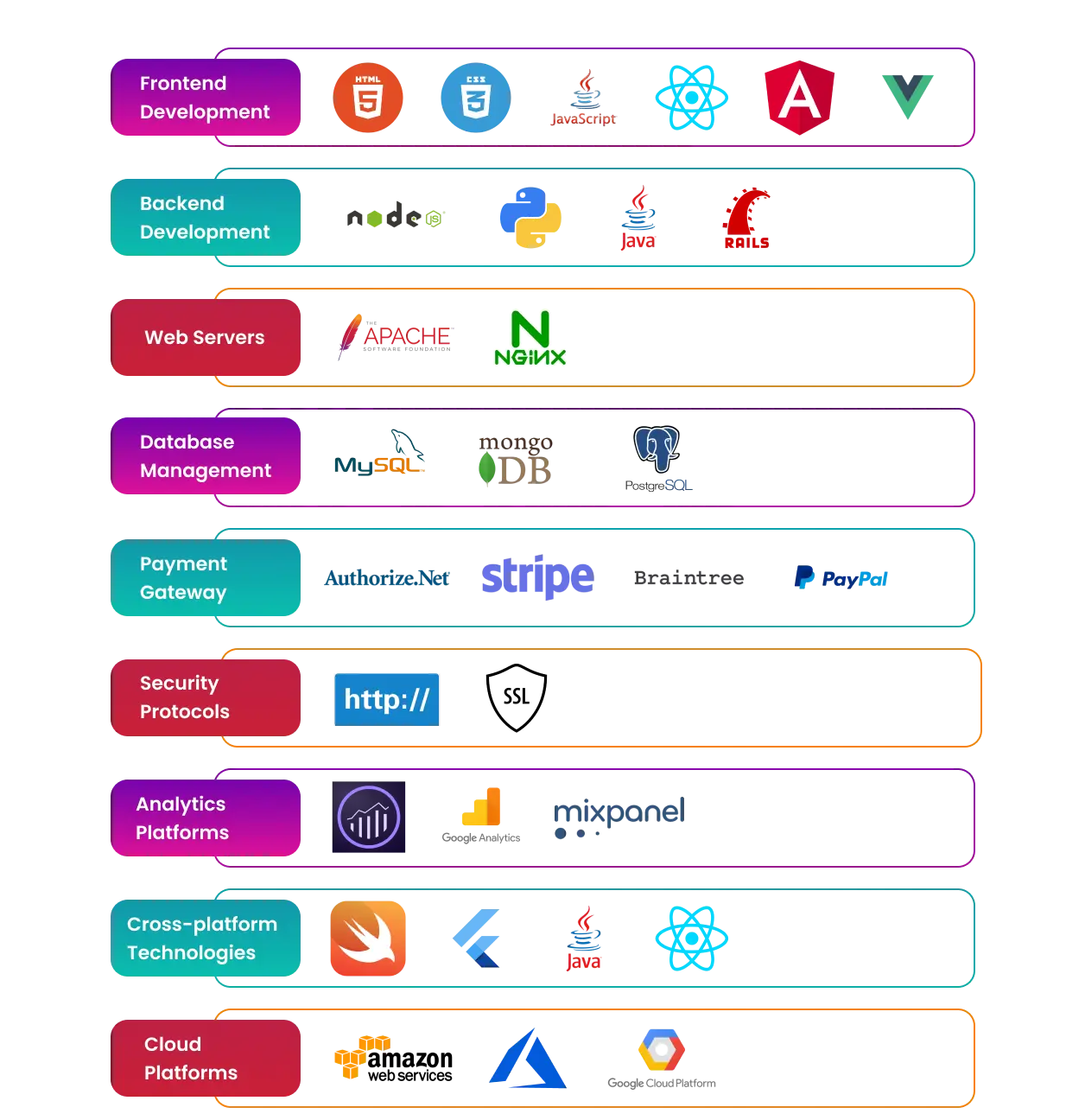
Frontend Development
- HTML5
- CSS3 (with preprocessors like SASS or LESS)
- JavaScript (with frameworks/libraries like React, Angular, or Vue.js)
Backend Development
- Programming languages: Node.js, Python, Java, or Ruby on Rails
- Web servers: Nginx, Apache
- Application frameworks: Express.js (for Node.js), Django (for Python), Spring Boot (for Java), Ruby on Rails (for Ruby)
Database Management
- Relational databases: MySQL, PostgreSQL
- NoSQL databases: MongoDB, Cassandra, Redis (for caching)
Payment Gateway Integration
- Payment gateway providers: PayPal, Stripe, Braintree, Authorize.Net
Authentication and Security
- User authentication: JWT (JSON Web Tokens), OAuth 2.0
- Security protocols: HTTPS, SSL/TLS encryption
- DRM (Digital Rights Management) solutions for content protection
Analytics and Monitoring
- Analytics platforms: Google Analytics, Mixpanel, Adobe Analytics
Cloud Infrastructure
- Cloud platforms: Amazon Web Services (AWS), Microsoft Azure, Google Cloud Platform (GCP)
Our team of expert developers leverage these technologies to build scalable, feature-rich applications that meet the demands of modern streaming audiences.
Hire Dedicated Team of Experts for Your OTT Platform Project
Our team will help you from requirement discussion to launch and maintenance.
They will guide you thoroughly during the project execution process for necessary
third-party selection and purchases.
8. Regulatory Compliance
Compliance with security regulations and privacy laws and adherence to regional or industry standards for content ratings are essential aspects of OTT platform development.
Ensuring compliance in these areas may necessitate additional resources and can impact development costs.
Key considerations include:
Data Encryption (HTTPS): Implement secure communication protocols such as HTTPS to encrypt data transmitted between users and the OTT platform. It ensures the confidentiality and integrity of user data.
Digital Rights Management (DRM): Implementing DRM technologies to protect copyrighted content from unauthorized access, copying, and distribution.
Compliance with Privacy Laws: Ensuring compliance with privacy laws such as the General Data Protection Regulation (GDPR), California Consumer Privacy Act (CCPA), and other applicable regulations governing the collection, processing, and storage of user data.
Content Rating and Filtering: Adhering to content rating standards and regulations to ensure that content is appropriately labeled and filtered based on age-appropriateness and content ratings.
Privacy Protection: Implementing privacy protection measures to limit the collection and processing of personal data to what is necessary for the intended purpose.
However, it’s essential to continuously monitor regulatory changes and adapt compliance strategies accordingly to ensure ongoing compliance with evolving security and privacy regulations.
9. Developer’s Location & Team Composition
The location of the developer and the composition of their development team are crucial factors influencing OTT platform development costs and project outcomes.
This cost varied due to differences in labor rates, overhead expenses, and currency exchange rates. Developers located in regions with lower labor costs offer competitive pricing for development services compared to high-cost regions.
Moreover, the location may also affect communication and collaboration processes if there are time zone differences or language barriers to consider. But it’s worth managing if you get lower development costs with quality service.
| Region | Hourly Rate (Approximate) |
|---|---|
| North America | $100 – $250 |
| Western Europe | $80 – $180 |
| Eastern Europe | $40 – $100 |
| South America | $30 – $70 |
| Asia (India) | $20 – $60 |
| Australia | $80 – $150 |
The next factor is team composition. To create an app with basic functionality, you will need the following specialists:
- Project Manager
- UI/UX Designer
- Frontend Developer
- Backend Developer
- Quality Assurance (QA) Engineer
Hire dedicated developers from us, as we are a leading OTT platform app development company in India, focusing on delivering the highest quality app with a lower labor rate.
Development Cost of Popular OTT Applications
Here’s an overview of the estimated development costs for popular OTT applications:
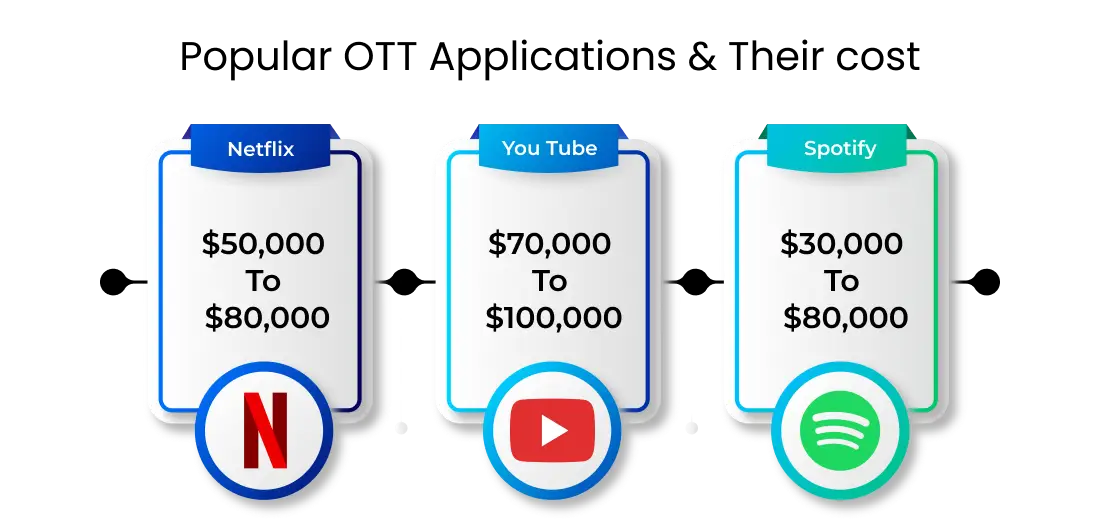
Netflix
Netflix, the pioneer in the OTT industry, has achieved remarkable success with its streaming platform, which offers a vast library of movies, TV shows, and original content to subscribers worldwide.
One of Netflix’s key revenue models is subscription-based, offering users access to a wide range of content through monthly subscription plans. Furthermore, it generates revenue through strategic partnerships and collaborations, such as co-production deals for original content with renowned filmmakers and production studios.
The company’s revenue in 2023 was around 33.7 billion U.S. dollars, with a strong base of 260 million paid subscribers worldwide.
To develop an OTT app like Netflix with basic features would cost you around $50,000 to $80,000. Meanwhile, if you are looking to include advanced features, it can cost you around $100,000 or more.
YouTube
YouTube is the world’s largest video-sharing platform. Launched in 2005, YouTube has evolved into a comprehensive multimedia platform that hosts a diverse range of videos. It includes user-generated content, music videos, tutorials, documentaries, and more.
With over 2 billion monthly active users and hundreds of hours of video uploaded every minute, YouTube has become an integral part of global internet culture and entertainment. It has generated $29.24 billion in revenue in 2023.
The OTT platform development cost, like YouTube, can range from $70,000 to $100,000 or more, depending on the platforms you want to cover and the complexity of the functionality.
Spotify
Spotify, founded in 2006, has become one of the leading global music streaming platforms. It provides users access to a vast catalog of songs, albums, playlists, podcasts, and more.
You might also want to explore how to create a podcast app.
With over 400 million active users across 170 countries, Spotify has transformed the music industry. This platform has provided on-demand access to millions of tracks from both major record labels and independent artists.
Spotify offers both free and premium subscription tiers to cater to different user preferences. It generated revenue of $14.72B in the year ending December 31, 2023, with 17.98% growth year-over-year.
If you are looking for OTT app development like Spotify, it will cost you around $30,000 to $80,000 or more, depending on the level of complexity and project scope.
Want to Know the Cost of Your OTT App?
Get a consultation from our experts to discuss pricing and explore custom
solutions tailored to your business needs.
Top OTT Monetization Strategy for OTT Platform Development
You might wonder how these free apps make money, but there are mobile app monetization strategies that help businesses maximize revenue and profitability.
Here, we will discuss three main video streaming monetization models that you can choose to implement in your OTT platforms.

1. SVOD (Subscription Video on Demand)
SVOD is a popular monetization strategy where users pay a recurring subscription fee to access a library of content. Users call subscribers, and they have unlimited access to the content available on the platform.
This model provides a steady stream of revenue for OTT platforms and builds customer loyalty through continuous content without ads. Examples of SVOD platforms include Netflix, Amazon Prime Video, and Disney+.
2. TVOD (Transaction Video on Demand)
TVOD, also known as pay-per-view or rental, allows users to purchase or rent individual pieces of content for a one-time fee. Users pay for access to specific movies, TV episodes, or live events on a per-item basis.
This model provides flexibility for users to choose and pay for only the content they want to watch, making it suitable for premium or exclusive content releases. Examples of TVOD platforms include iTunes, Google Play Movies, and Amazon Instant Video.
3. AVOD (Advertising Video on Demand)
AVOD is a monetization strategy where users can access content for free, but advertisements are shown during playback. The primary source of income for AVOD platforms is the ad revenue generated from advertisers.
This model provides free access to content for users and also allows advertisers to reach a large audience through targeted ads. AVOD platforms often offer a combination of both free and premium content to attract users while generating revenue through advertising. Examples of AVOD platforms include YouTube, Hulu (with ads), and Roku Channel.
Confused Which Monetization Model To Choose?
Get free consultation on choosing the right monetization model for your OTT platform.
Tips for Optimizing OTT App Building Cost
Here, we will discuss a few tips that you can incorporate into your OTT app development strategy for a successful and cost-effective development process.
- Take up the MVP approach to prioritize essential features and launch your OTT app with minimal functionality.
- Consider using cost-effective and scalable technologies that align with your project goals.
- Opt for open-source frameworks, libraries, and third-party APIs to reduce development time and costs. It includes using pre-built components for authentication, payments, analytics, and content management.
- Utilize cross-platform development frameworks like React Native, Flutter to build your OTT app for multiple platforms (e.g., iOS, Android, web) using a single codebase.
- Consider outsourcing to a specialized OTT app development company, as it helps to reduce overhead costs and leverage their expertise in building OTT platforms.
- Use cloud services and infrastructure, such as AWS, Azure, or Google Cloud Platform, to host your OTT app and manage resources cost-effectively.
How Can Guru TechnoLabs Help You With OTT App Development?
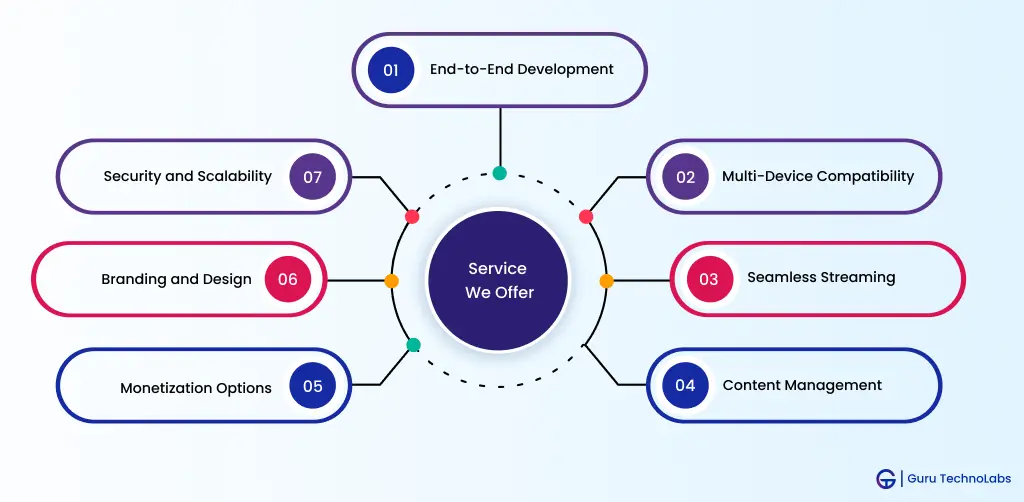
Begin your OTT app development journey with Guru TechnoLabs. Our team specializes in crafting customized OTT apps tailored to your unique business needs.
You’ll be the boss when you choose Guru TechnoLabs for your OTT app. You’ll decide how users sign up, design screens that are easy to use, and pick the videos you want to show – all to create an amazing experience for your viewers.
However, building a successful OTT app goes beyond just the platform itself. That’s where our seamless integration services come in. We’ll provide comprehensive solutions to support your OTT initiative, from securely managing and distributing your content to implementing global monetization strategies.
Here’s how we can turn your OTT vision into reality:
1. End-to-End Development: We don’t just build apps; we create everything you need for your OTT platform. This includes mobile apps, the web app for desktops and laptops, and even backend systems to manage content, users, and billing.
2. Multi-Device Compatibility: We’ll make sure your app looks great and works flawlessly on phones, tablets, smart TVs, game consoles, and any device your viewers might use.
3. Seamless Streaming: Smooth, lag-free streaming is essential for a great user experience. We will configure your app to deliver high-quality content without buffering or interruptions.
4. Content Management: We’ll easily build features to upload, organize, and manage video content. You’ll be able to add descriptions, categorize videos, and keep everything organized for your viewers.
5. Monetization Options: We can help you make money from your OTT app. We can integrate features for subscriptions, pay-per-view, or even in-app advertising.
6. Branding and Design: Your OTT app should reflect your brand. Our design team will create a user-friendly and visually appealing interface that matches your brand identity.
7. Security and Scalability: Security is critical. We’ll build your app with robust security features to protect your content and user data. We’ll also design it to scale as your user base grows.
By working with Guru TechnoLabs, you get a reliable partner who can guide you through the entire OTT app development process, from initial concept to launch and beyond.
Ready to save money on your OTT app development?
Get in touch with us and start your OTT app development
journey today.
Conclusion
In conclusion, we have explored the varied landscape of OTT platform development costs by delving into the various factors.
Armed with this knowledge, if you are ready to begin your OTT development journey and need assistance with development, feel free to reach out to us.
At Guru TechnoLabs, we understand the importance of cost-effective yet high-quality OTT platform development. Our team of experienced professionals is equipped with the skills and expertise needed to navigate the complexities of OTT platform development while keeping costs optimized. We are committed to delivering top-notch solutions tailored to your specific requirements.
FAQs About OTT Development
OTT video apps can grow your business by providing a direct-to-consumer distribution channel. It helps you reach a global audience by providing personalized content recommendations, enabling subscription-based revenue models, facilitating targeted advertising opportunities, and enhancing user engagement through interactive features and social sharing functionalities.
The best video-on-demand (VOD) revenue model depends on various factors, such as your target audience, content library, monetization goals, and market trends. Common VOD revenue models include subscription-based (SVOD), transactional-based (TVOD), advertising-based (AVOD), hybrid models, and freemium models with premium content tiers.
If you are developing OTT video apps, it involves several steps, including:
- Defining project goals and requirements
- Designing UI/UX
- Selecting a tech stack
- Developing backend
- Integrating third-party services
- Testing for QA
- Deploying the app
The reason behind the growing popularity of OTT platforms is their affordability. Traditional TV viewing can be expensive for users who have to pay for a bundle of channels even if they are interested in a few. At the same time, OTT platforms offer various subscription plans that cater to different budgets, which users can enjoy thoroughly.
As of the latest available data, there is a rapidly growing base of OTT users by +19.88 %. The numbers will continuously increase between 2024 and 2029 by a total 936.9 million users.
Customers prefer OTT over traditional platforms due to its convenience, flexibility, and on-demand access to a vast library of content. It provides personalized recommendations, ad-free or limited ad experiences, cross-device compatibility, and the ability to consume content anytime, anywhere, without the restrictions of traditional broadcast schedules.
On average, it can take 3-6 months to develop and launch an OTT platform. The timeline for OTT platform development varies based on factors such as project complexity, scope, desired features, technology stack, and team size. Read in detail about the timeline of app development.
Key features to consider while developing an OTT platform:
- User-friendly interfaces
- Personalized content recommendations
- Seamless streaming experiences across devices
- Secure payment gateways for subscriptions
- Robust content management systems
- Analytics for user engagement
- Social sharing functionalities



